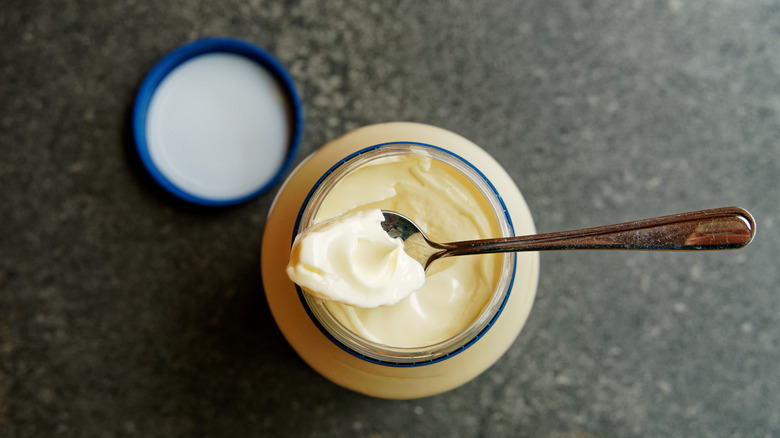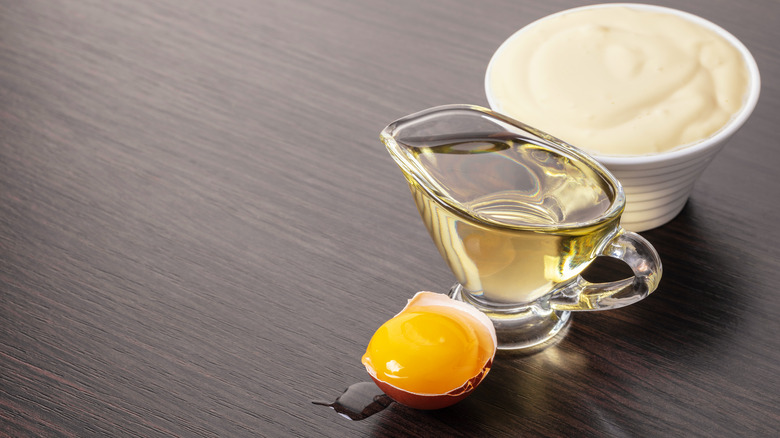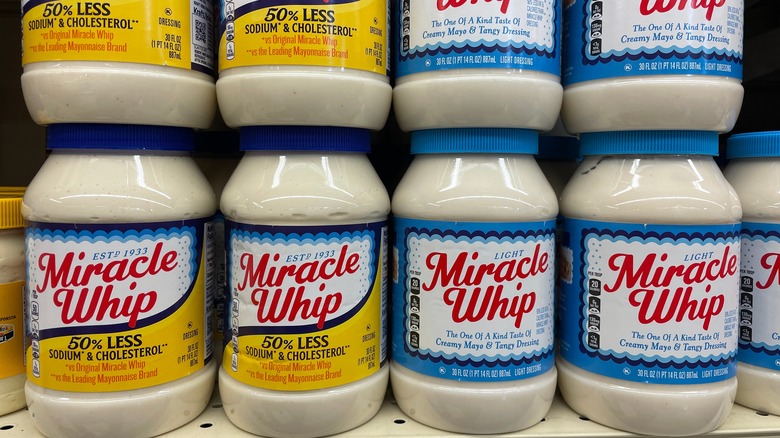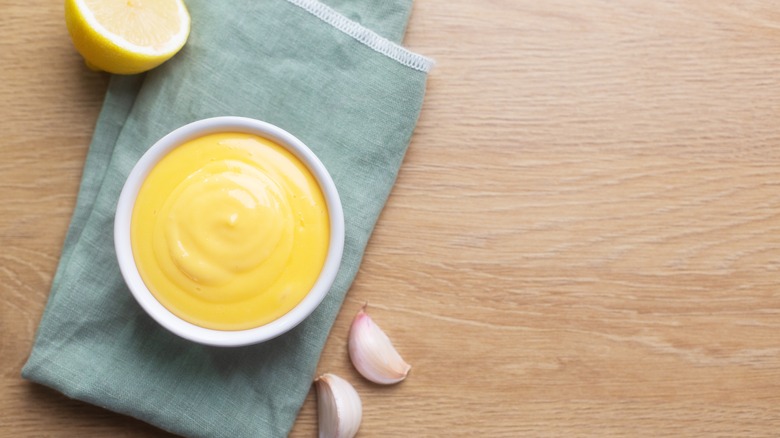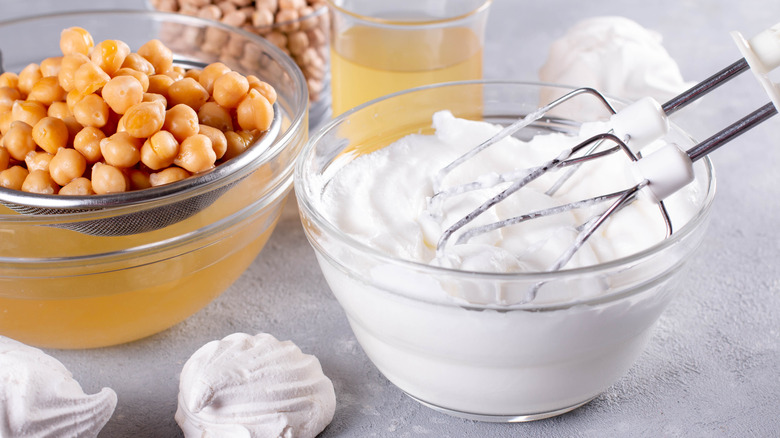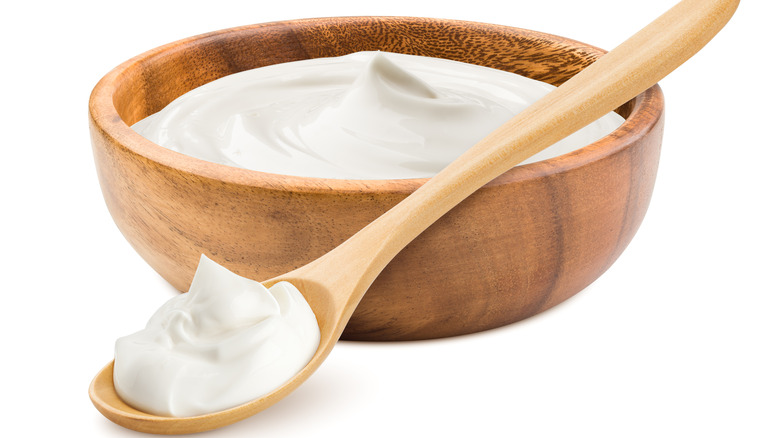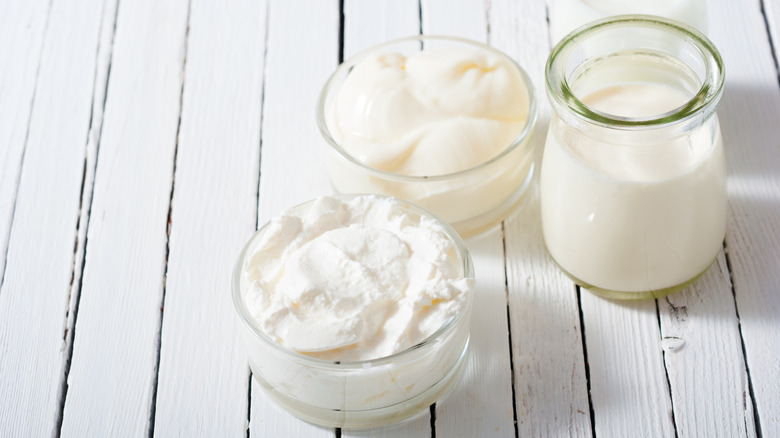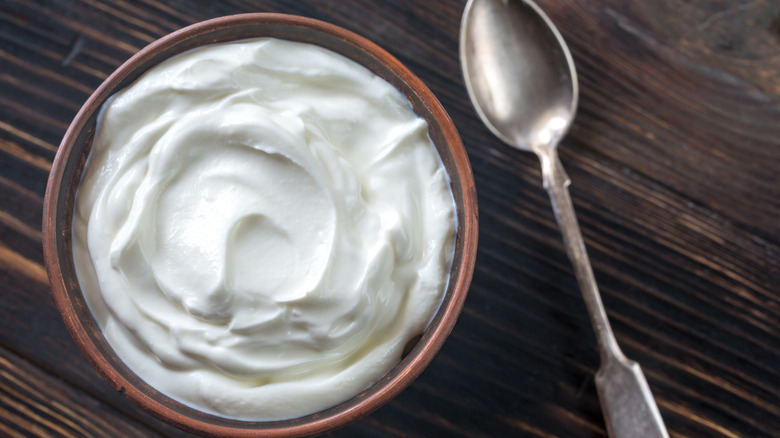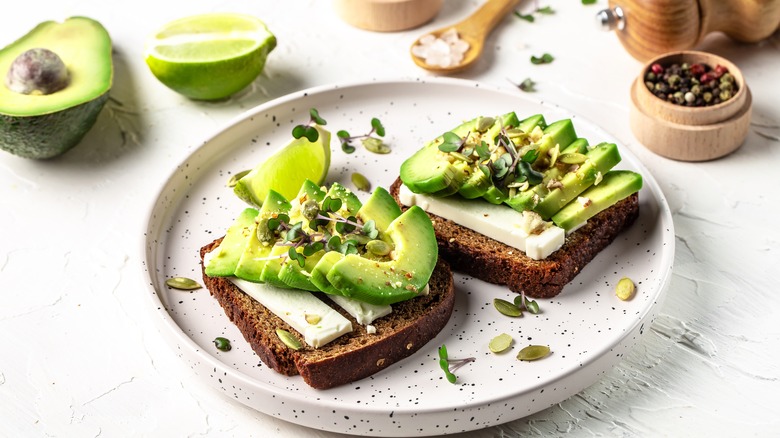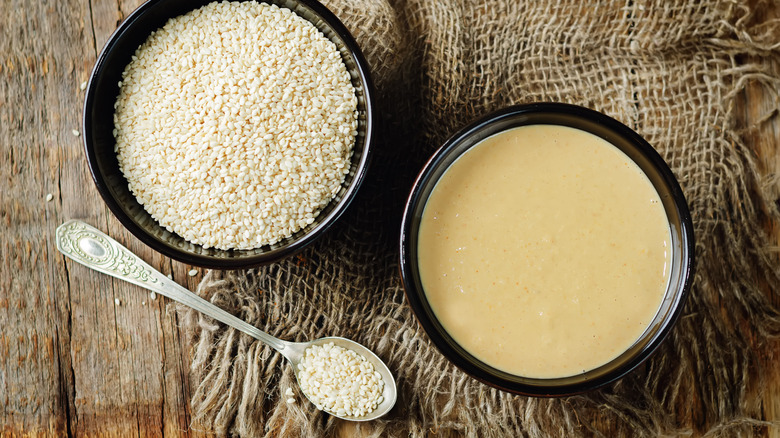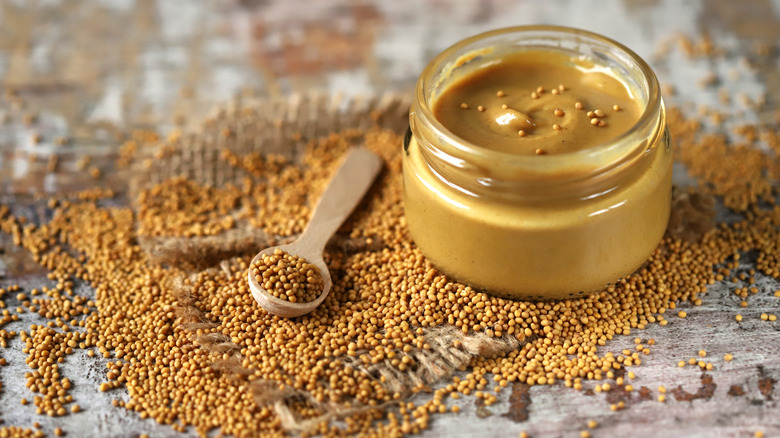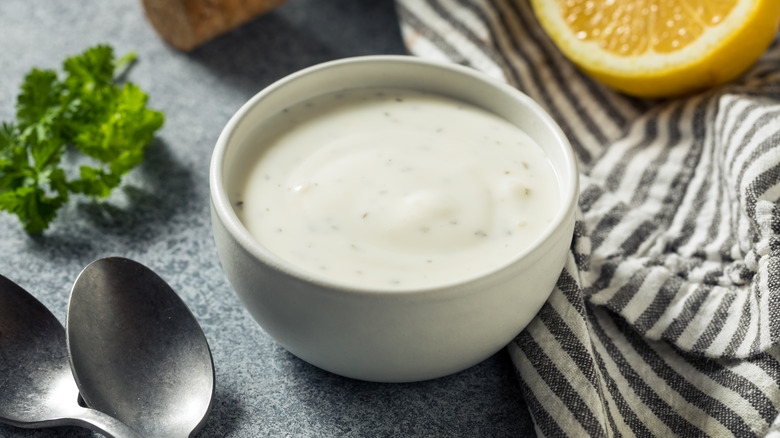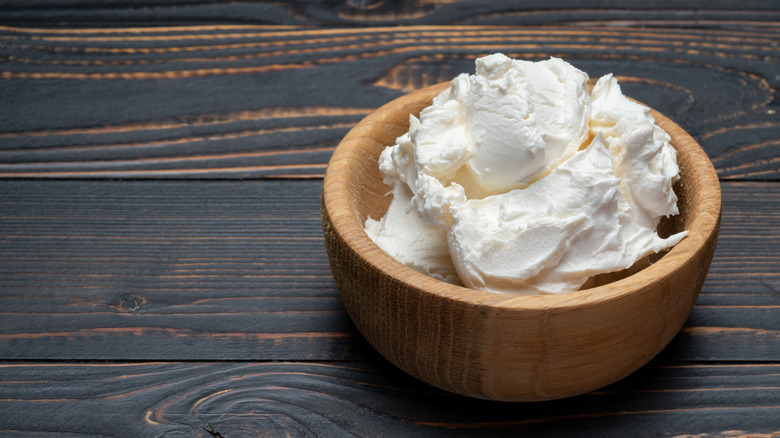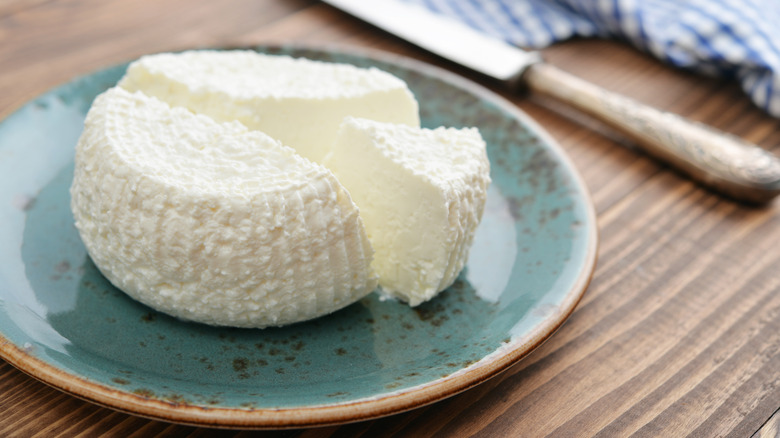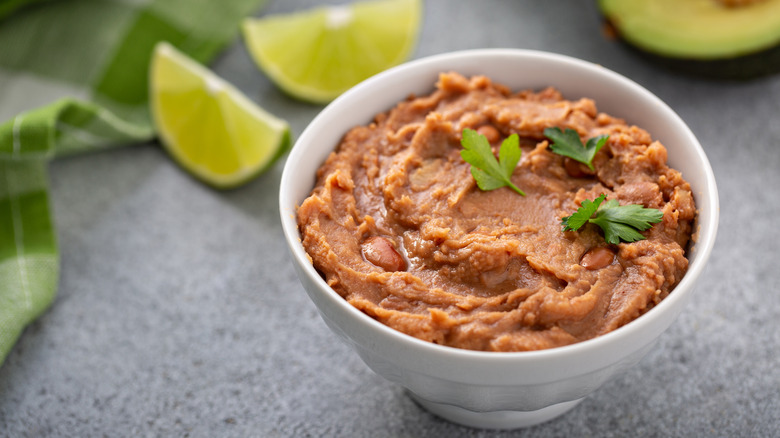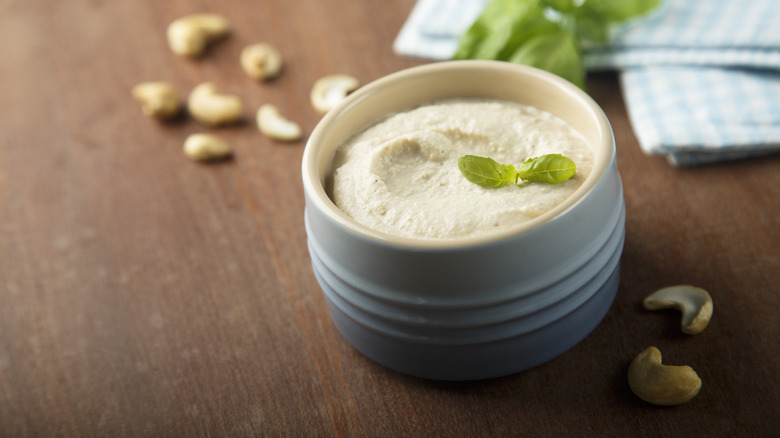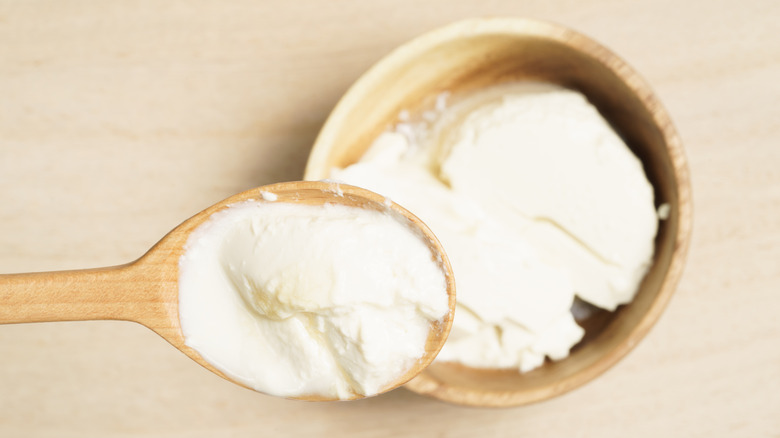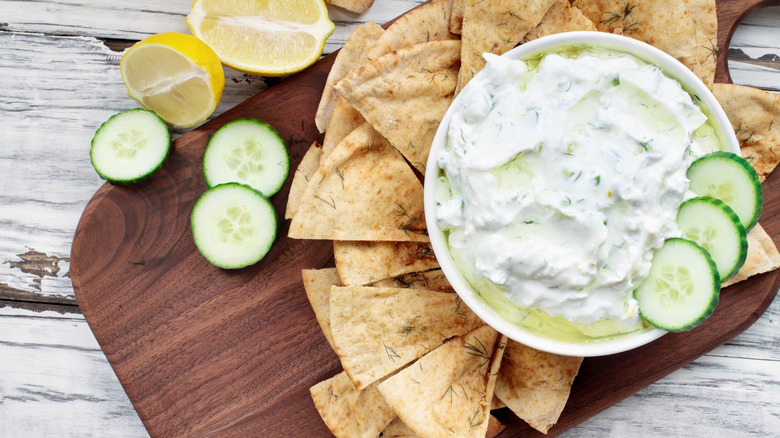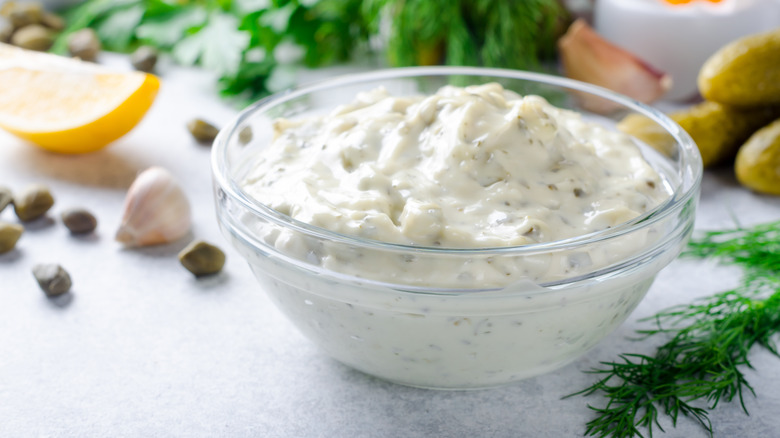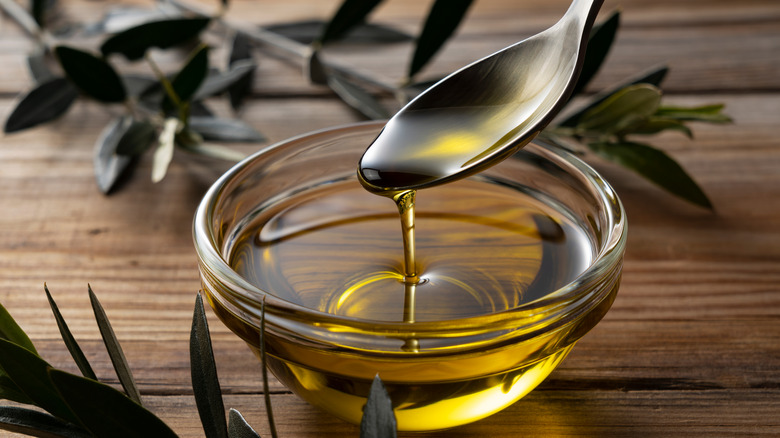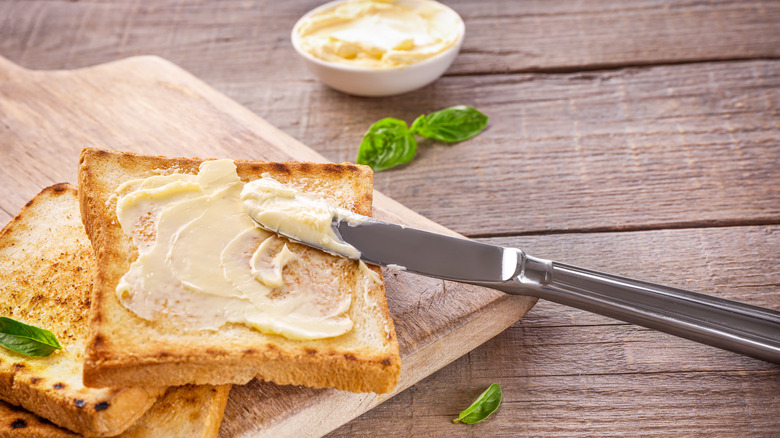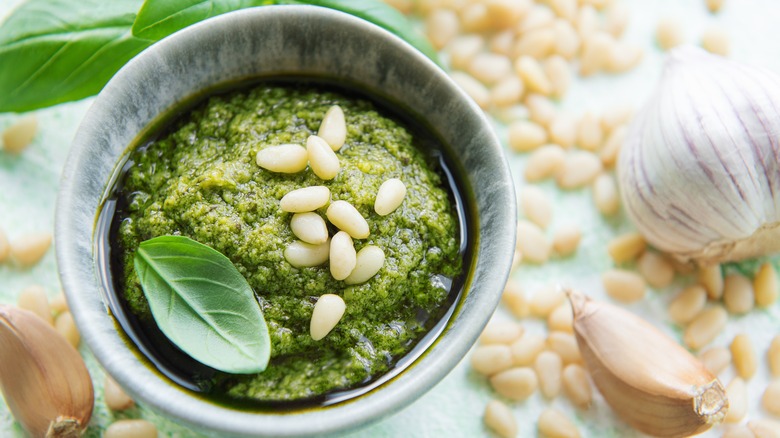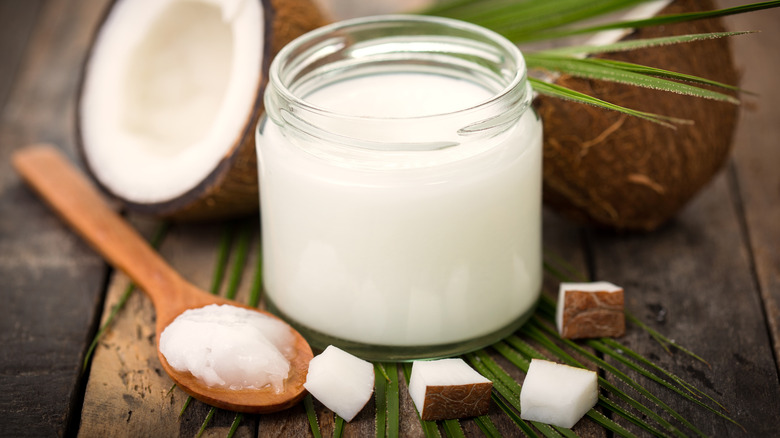The 23 Best Substitutes For Mayonnaise
Mayonnaise is one of those love-it-or-hate-it condiments, but there's no denying the usefulness of this versatile condiment. Mayonnaise has many more uses than just being spread in a healthy layer onto sandwiches or mixed with egg yolks to make a batch of classic deviled eggs. It can be added to mashed potatoes or quiche to add richness, slathered onto steaks or bread to create a pleasantly crusty exterior, or added to marinades and salad dressings. Although it sounds weird, it's also fantastic for baked goods, and adding mayonnaise to your cake locks in moisture and enhances the flavor.
So what happens when you're out of mayo? Or you're staring down an empty shelf during a grocery store shortage? Luckily, there are dozens of excellent substitutes for mayonnaise. Some work as an equal part swap, while others are better suited for cooked or raw applications. We'll look at each one — and when it's best to use it.
Eggs
If you don't have any mayonnaise on hand, the best substitute is to make your own with eggs. Classic mayonnaise recipes combine oil and eggs, creating an emulsion that transforms the two liquids into a thick, spreadable condiment. You can add flavorings like lemon juice, mustard, salt, and pepper to the mayonnaise, but all you really need for a basic substitute is an egg and cooking oil. This substitute is great because it works in every recipe that calls for mayonnaise.
To make homemade mayonnaise from eggs, simply separate an egg yolk (saving the whites for another use). Then, slowly drizzle one cup of oil into the yolk, vigorously whisking as you go. Neutral oil, like vegetable oil, is the typical choice, but any cooking fat works (including olive oil and duck fat). You can use a food processor or blender if you want to save yourself from a workout.
Miracle Whip
These two condiments have vastly different flavors, with most people being either team mayonnaise or team Miracle Whip. However, they do work as equal parts substitutes for each other. What makes Miracle Whip and mayo different is the blend of ingredients. Mayonnaise is made with eggs, oil, and lemon juice (or vinegar). Miracle Whip is sweeter and tangier, containing sugar or high fructose corn syrup, added water, and spices like garlic, mustard, and paprika.
While the two taste very different, they have a similar texture, and both works to bind ingredients when used for dishes like tuna salad or potato salad. Keep in mind that Miracle Whip has a different fat content, so it's not ideal for searing meats or making grilled cheese. You may also want to adjust the other ingredients when using it as a salad dressing to compensate for the extra sweetness.
Aioli
Although the two terms are sometimes used interchangeably, there is a difference between aioli and mayonnaise. They're the same texture, but that's where the distinction ends. Mayonnaise has a mostly neutral flavor and color. It may be seasoned with lemon juice or mustard, but it remains lightly tangy and tastes rich like eggs. On the other hand, traditional aioli is made by combining mashed garlic with olive oil, and while most recipes contain egg yolks, some do not. It's bold and vibrant, and it's often bright yellow from the use of yolks only.
All things considered, these two condiments are similar enough to make homemade aioli a suitable substitution for most recipes with mayonnaise. Remember that using aioli will impart a strong garlic flavor to the dish, though, so it probably won't be the best choice when used in desserts or baked goods. That same flavor would really shine on a turkey sandwich, though.
Aquafaba
Anyone following a vegan diet may already be familiar with aquafaba, the water left over after draining a can of beans like chickpeas. When whipped vigorously like egg whites, this liquid turns into an ingredient you can swap for eggs when baking. Slowly adding oil to the beaten liquid transforms it into a similar taste and texture to mayonnaise, making it a suitable substitution in any recipe.
For best results, look for kombu on the ingredients list when buying canned chickpeas for aquafaba. This ingredient helps stabilize the whipped mixture, preventing it from losing shape. If you can't find it, don't worry; you can add cream of tartar or sugar to the liquid to help it keep its form.
Sour cream
When it comes to flavor, sour cream and mayonnaise have nothing in common. Sour cream is light and tangy, while mayonnaise is rich and eggy. The two share similar texture and viscosity, so sour cream is an excellent substitution in most raw recipes that call for mayonnaise. It doesn't have the same fat content as mayonnaise, so consider adding a little olive oil to the sour cream to amp up the richness.
Use sour cream as a mayonnaise replacement in salad dressings or for your next batch of deviled eggs. The sour flavor will add a fun spin to these classic recipes. This substitution also works well in baked goods to add moisture to cakes and muffins, but sour cream wouldn't be a good choice for other cooked recipes, like searing meats and making grilled cheese. It just doesn't transmit heat the same way as fat-rich mayonnaise.
Crème fraîche
The similarities between crème fraîche vs. sour cream make it a suitable substitute for mayonnaise — both are made from heavy cream and share a similar sour taste. Of course, it's important to note the difference between the two substances because it affects how you'll use crème fraîche in this substitution.
For starters, crème fraîche has a thinner consistency than sour cream and mayonnaise. It's also nuttier and sweeter compared to sour cream's tart, sour flavor, and mayonnaise's rich egg character. When using crème fraîche instead of mayonnaise, remember that it will bring a sweet edge to the dish. We wouldn't recommend using it in large quantities, as the flavor will be quite pronounced, and it may also thin out the texture of your recipe.
Greek yogurt
Greek yogurt has a nice, thick texture, which is similar enough to mayonnaise's thick, spoonable consistency. Like sour cream, we recommend adding a few tablespoons of oil to Greek yogurt when using it as a salad dressing since it's not as naturally rich. This is especially true if you're using nonfat yogurt.
When it comes to the type of yogurt to use for this swap, remember that there's a difference between Greek yogurt and regular yogurt. We recommend using the former because it's strained, giving it a thicker consistency. It's also best to look for unflavored yogurt, as added sugar or fruit flavors could cause weird flavor interactions.
Avocado
This is one of our favorite fresh ingredient swaps that can take the place of mayo. Avocado is a fantastic substitute for mayonnaise on sandwiches or burgers because it's full of healthy fats, making it just as creamy and rich as mayonnaise. It's not a suitable substitution for most cooked applications (like slathering on the outside of the bread to make grilled cheese), but avocado works well as a spread, salad dressing, or in vegetable salads like potato salad.
For bound salads, keep in mind that you'll need to blend the avocado well to create a smooth consistency. Otherwise, the mushiness could detract from the overall eating experience. The color will also be affected, so only use avocado if you're okay with your deviled egg yolks having a green tinge!
Hummus
Hummus is another one of our go-to substitutes for mayonnaise on sandwiches and wraps. This vegan-friendly alternative to egg-rich mayonnaise is made from chickpeas, tahini, lemon juice, and spices. It contains more protein and fiber than most condiments, giving it healthy bonus points.
It would be weird to use hummus in baked goods, as the flavors of spiced hummus would clash with something like chocolate cake or blueberry muffins. On the other hand, it's a perfect substitute when used as a sandwich spread, and these flavors also work for dishes like deviled egg filling. If you're concerned about flavor interactions, you can always make homemade hummus and skip the garlic and spices.
Tahini
You may know tahini from its use in making hummus. This mixture of ground sesame seeds and oil has a very different flavor from mayonnaise — nutty, earthy, and lightly bitter — but its texture is similar enough to use in salad dressings or other raw applications.
We've found that some tahinis are thicker than others, depending on the brand. You may need to thin out tahini with a little water before using it to get it to match the mayonnaise's texture. You'll also want to consider the types of tahini before using this swap, which can affect the finished flavor. Unhulled tahini tends to be more bitter than the hulled variety, and roasted or toasted tahini has deeper, more robust flavors. Raw tahini is a good choice when in doubt because of its lighter taste.
Mustard
If you want to add a bold flavor to potato salad, tuna salad, or egg salad, use mustard as a substitute for mayonnaise. You can use any type of mustard, from tart yellow mustard to mild Dijon or gritty whole-grain mustard. Of course, mustard's strong flavor makes it less than ideal for use in baked desserts, but it works for most raw applications where the flavor is appropriate. It's also a good swap for searing meats, like mustard-crusted rack of lamb.
Mustard is also a wonderful choice when making salad dressings, as mustard acts as an emulsifier like eggs and mayonnaise. According to America's Test Kitchen, whole-grain mustard creates the most stable emulsions, and Dijon mustard is a suitable choice, too.
Creamy salad dressing
Many salad dressings use mayonnaise as a base ingredient, and they work almost as well as mayonnaise in bound salads like tuna or chicken salad. While they won't be as thick as mayonnaise, they have a similar enough texture. Look for creamy, thick dressings made with mayonnaise, buttermilk, sour cream, or yogurt, like ranch, Caesar, Russian dressing, or blue cheese.
Each dressing will bring along its own flavor profile, so choose wisely before adding it to your recipe. Blue cheese might be too bold for deviled egg filling, and Caesar dressing might overpower delicate tuna. However, these might be the flavors you're going for, so have some fun with them!
Cream cheese
This thick cheese is iconic for its use on bagels, but it can also be used in many recipes that call for mayonnaise. It's best to soften cream cheese before using it, leaving it on the counter for 15 to 20 minutes, briefly heating it in the microwave, or placing it in warm water for about ten minutes.
To get the consistency right, we recommend beating cream cheese to make it spreadable. That could be done by hand with a whisk, but it's much easier with an electric hand mixer or a stand mixer. When using cream cheese for dressings or bound salads, try mixing it with yogurt or sour cream to get the right consistency. If you prefer, you can use mascarpone here. It's richer than cream cheese, but it works just as well.
Ricotta cheese
Ricotta cheese is made by introducing acid (like lemon juice or vinegar) to the whey leftover during the cheese-making process. That creates a mildly sweet, creamy cheese that's smooth enough to be spreadable (but not so smooth that it doesn't have a slightly grainy texture). To make ricotta's texture ideal, apply the cream cheese principle: Whip it with an electric mixer and combine it with yogurt or sour cream to create the right texture.
When baking with ricotta as a substitute, look for full-fat ricotta. It's richer and creamier than low-fat ricotta, so it will do a better job of keeping your baked goods from becoming dry because of fat's role in adding moisture.
Bean puree
We love using bean puree in surprising ways, like as a way to add more protein to pizza. These purees can also be used as a swap for almost every mayonnaise recipe. A white bean puree works really well as a spread for sandwiches or wraps, and it also works like mayonnaise to add body to dressings.
You can even bake with beans. The Bake School confirms that adding pureed canned beans to a cake will add the same level of moisture as eggs or mayonnaise. Your only choice here is which beans to use. For example, white beans have a mild taste, while lima beans boast a distinctly savory flavor.
Cashew cheese
When it comes to egg-free mayonnaise alternatives, cashew cheese is incredible. Also called cashew cream, this vegan spread is made by blending soaked cashews with flavoring components like nutritional yeast, turning the dense nuts into a soft, spreadable product.
The best part about cashew cheese is that the consistency is up to you. It can be thick, like cream cheese, or thin, like queso, depending on how much water you add. If you're cooking with cashew cream, be warned that it will get thicker as it cooks, so make sure it's thinner than the mayonnaise before adding it to the mix.
Tofu
There are several unconventional ways to use tofu, and replacing mayonnaise is one of them. Silken tofu can be turned into vegan mayonnaise by blending it until it's smooth. It's also okay to use in baked goods instead of eggs, which means it can also be used as a replacement for mayonnaise in baked goods. A general rule of thumb is to use 1/4 cup of tofu for each egg or every three tablespoons of mayonnaise.
Not all types of tofu make good mayonnaise substitutes, though. Firm and extra-firm tofu has been pressed to remove the moisture, so its texture is better suited for pan-frying or turning into crumbles. Stick with soft or silken tofu as a mayonnaise substitute because of its naturally custard-like consistency.
Tzatziki
If Greek yogurt makes a good substitute for mayonnaise, then tzatziki also fits the bill. A classic tzatziki sauce recipe combines Greek yogurt with cucumber, lemon, garlic, mint, and olive oil, turning plain yogurt into a zippy condiment that's perfect for sandwiches.
Cucumbers break down and become very watery when heated, so we don't recommend this swap for cooked applications. Instead, use tzatziki in any raw mayonnaise recipe that would benefit from the flavors of this tangy, well-seasoned Mediterranean sauce. It would make a really interesting twist on deviled eggs!
Tartar sauce
This mayonnaise-based dressing is the typical accompaniment for seafood dishes like fish and chips, but tartar sauce doesn't only have to be a seafood condiment. To make tartar sauce, mayonnaise is enriched with flavorful herbs, lemon juice, and relish or chopped pickles. Some recipes also include salty capers and olives in the mix.
Put it all together, and you have a flavor-packed sauce that would taste great on a sandwich instead of mayonnaise. Those flavors would also work well with salads like tuna or egg salad. The chunky pickles in tartar sauce will stand out, so don't plan to use this one for any recipe that requires a smooth condiment.
Olive oil
Oil is a critical component in making mayonnaise, so it stands to reason that it makes a decent substitute. Olive oil lacks mayonnaise's creamy consistency, so it's not good for spreading on sandwiches, but it will add moisture and fatty flavor to dressings, marinades, and salads.
When baking, Bob's Red Mill advises that you can use olive oil to replace one egg (or three tablespoons of mayonnaise) by swapping in 1/4 cup olive oil. However, it cautions that adding too much olive oil can make baked goods greasy, so this is only a good substitute in small quantities.
Butter
If you're planning to use mayonnaise to create a crusty exterior on grilled cheese sandwiches, try using butter instead. Butter has a similar fat content to mayonnaise, so the two can be used interchangeably when cooking to promote the Maillard reaction (the chemical reaction that gives foods that appealing, crispy, brown exterior).
This suggestion only applies to cooked applications, as butter's texture would make a very poor substitute for mayonnaise in raw recipes. When raw, its texture is either too hard or too soft, depending on the ambient temperature.
Pesto
When color isn't a factor, try using pesto instead of mayonnaise. Pesto is a combination of herbs, garlic, oil, cheese, lemon juice, and nuts (specifically, basil, Parmesan cheese, and pine nuts in a traditional pesto recipe). It's herbaceous and bright, and the oil and cheese provide enough fat to make it a suitable mayonnaise replacement on sandwiches and salads.
The flavors in pesto would clash with sweet desserts, so we don't suggest this substitution for baked goods. In general, it's not a great swap for cooked dishes, either, as the bright green herbs tend to turn brown when heated.
Coconut cream
We're always excited to learn about new plant-based substitutes, so we were thrilled when we learned that coconut cream makes a good substitute for mayonnaise. It's rich and thick, and it's flavor lends a tropical vibe. That might not be a fit for a roast beef sandwich, but it'd be perfect for a fun twist on chicken salad.
There are several coconut-based products at the grocery store, and there's a big difference between coconut milk and coconut cream. Look for the container that's specifically labeled as "coconut cream." Regular coconut milk will be too watery, and coconut cream contains less water than coconut milk and has more fat, giving it a suitable consistency for replacing mayonnaise. Avoid anything called cream of coconut, which has added sugar.
